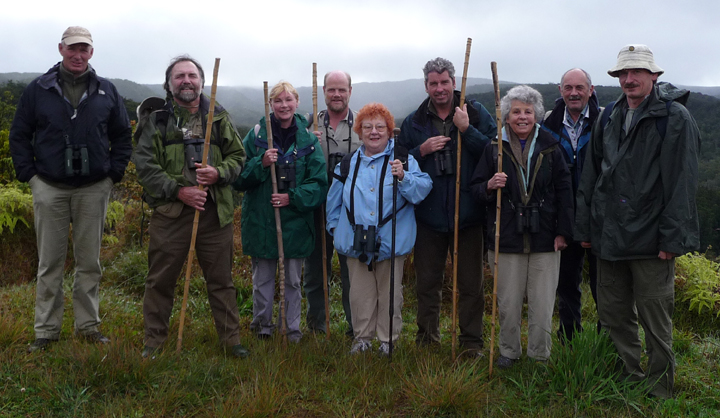Home | Tours | Trip Reports | News | Team | Calendar | Links | Contact | Store | Mailing List
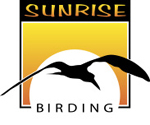 HAWAII
HAWAII Photos & Trip Highlights
March 29 - April 10, 2009
Leaders: Gina Nichol, Steve Bird, & David Kuhn
TRIP REPORT>> PHOTO HIGHLIGHTS>>
Download trip report (pdf)>> Species List (pdf) >>
HAWAII 2009 - Trip Report
By Gina Nichol.
For photo credits, mouse over each photo.
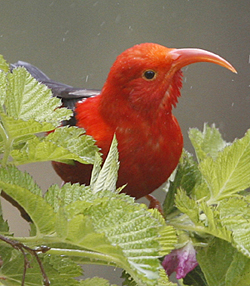
Day 1 - Sunday, March 29, 2009
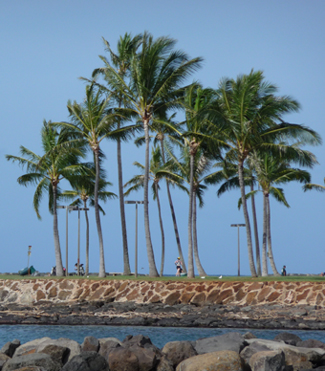 Most everyone arrived at least one day before the tour so they could enjoy a day to recover from the long journey to Hawaii. Excited to be in a new and exotic place, all of us took advantage of the extra day in Oahu enjoying a variety of activities including a helicopter ride, visits to historic Pearl Harbor, the Zoo and the Aquarium, and exploring the Waikiki Harbor Our hotel overlooked the waterfront with stunning views of the Pacific Ocean. At 6 o’clock in the evening we all met for the official beginning of the tour. Our guide David Kuhn had flown in from Kauai early and already scouted some birding areas on Oahu. After introductions and a brief orientation, we went out for a lovely dinner.
Most everyone arrived at least one day before the tour so they could enjoy a day to recover from the long journey to Hawaii. Excited to be in a new and exotic place, all of us took advantage of the extra day in Oahu enjoying a variety of activities including a helicopter ride, visits to historic Pearl Harbor, the Zoo and the Aquarium, and exploring the Waikiki Harbor Our hotel overlooked the waterfront with stunning views of the Pacific Ocean. At 6 o’clock in the evening we all met for the official beginning of the tour. Our guide David Kuhn had flown in from Kauai early and already scouted some birding areas on Oahu. After introductions and a brief orientation, we went out for a lovely dinner.
Day 2 - Monday, March 30, 2009
We had an early breakfast this morning and as the sun rose over Oahu we left the hotel for our first look for Hawaii’s birds in the hills above Honolulu. We were already very familiar with the common birds having seen many Zebra Doves, Spotted Doves, and Common Mynas on our pre-tour day. Our first Pacific Golden Plovers were seen along the road out of town and some of them were beginning to take on their handsome breeding plumage. The numerous Red Junglefowls were of questionable origin throughout the tour. We drove through a lovely area overlooking the city and stopped along the tree-lined road. An Oahu Amakihi was calling but remained elusive initially. Other introduced species were seen including Red-vented and Red-whiskered Bulbul, Japanese White-eye, House Finch, and Red-billed Leothrix. David heard the call of an Amakihi further up the hill so we moved up and surveyed the trees. Eventually a female flew into a tree right above us and showed well – our first authentic Hawaiian bird! From here we drove to another residential area and walked a woodland trail in search of our second endemic and a specialty here the - Oahu Elepaio . David’s sharp ears heard a call and soon the bird came in close and then quickly moved back into the forest. Most of us got excellent views of this endemic and now we had two specialties under our belt.
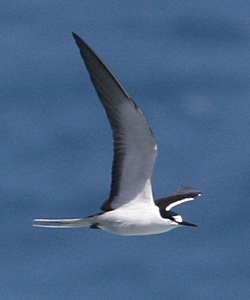 We drove out toward the southeast coast of Oahu where the wind was whipping up the surf and waves were crashing fiercely into the rugged cliffs. The bright sun made visibility a challenge but soon had our first Great Frigatebird, White-tailed Tropicbirds, a flock of Sooty Terns and a distant Fairy Tern. The light made it tricky to discern the Gray-backed from the Sooty Terns and Gina was able to spot one that disappeared all too soon. We moved up the road and pulled off in an area were Red-tailed Tropicbirds were flying very close to the road allowing cracking views as they drifted up over the edge of the cliff. Fantastic! There were two pairs both flying backward in tandem as part of their courtship ritual making an extraordinary scene.
We drove out toward the southeast coast of Oahu where the wind was whipping up the surf and waves were crashing fiercely into the rugged cliffs. The bright sun made visibility a challenge but soon had our first Great Frigatebird, White-tailed Tropicbirds, a flock of Sooty Terns and a distant Fairy Tern. The light made it tricky to discern the Gray-backed from the Sooty Terns and Gina was able to spot one that disappeared all too soon. We moved up the road and pulled off in an area were Red-tailed Tropicbirds were flying very close to the road allowing cracking views as they drifted up over the edge of the cliff. Fantastic! There were two pairs both flying backward in tandem as part of their courtship ritual making an extraordinary scene.
Further on along the coast road we made another stop overlooking the sea and two offshore islands. There were many Red-footed Boobies flying by and thousands of Sooty Terns over and around the larger island. A distant Wedge-tailed Shearwater was seen as well as our first Brown Noddies. Bart noted a Cattle Egret on the smaller island and appreciation of this was cut short by the sighting of a Brown Booby. Some of the Sooty Terns were being pushed over the shore by the strong wind making for incredibly close views. On the shoreline side of the bigger island there were four endemic Hawaiian Monk Seals hauled out on the sand and we enjoyed scope views of these critically endangered marine mammals. Thought to be extinct in the early 1800’s after commercial hunting for fur, oil and food nearly wiped this species out, between Hawaiian Monk Seals breed on the smaller islands of Hawaii and it is unusual to seem them hauled out on the main islands.
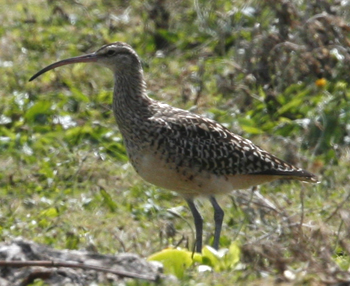 We continued driving up to the northeast coast stopping at Laie Point where it was still very windy. More Brown Noddies were seen passing in front of a jetty and as we watched David saw a spout of a whale close to shore. We kept watch on the area and enjoyed good views of two Humpback Whales moving together, spouting and logging just offshore. These enormous creatures return to Hawaiian waters each year to raise their calves which are born with no blubber and must put on a layer of fat insulation before heading north to feed in polar waters.
We continued driving up to the northeast coast stopping at Laie Point where it was still very windy. More Brown Noddies were seen passing in front of a jetty and as we watched David saw a spout of a whale close to shore. We kept watch on the area and enjoyed good views of two Humpback Whales moving together, spouting and logging just offshore. These enormous creatures return to Hawaiian waters each year to raise their calves which are born with no blubber and must put on a layer of fat insulation before heading north to feed in polar waters.
Further on up the coast, we stopped at another area and walked along a golf course to an open area scrubby behind some sand dunes. As we approached, our first Bristle-thighed Curlews were seen. Another endangered species, Bristle-thighed Curlews breed in Alaska and winter in Hawaii. It was particularly exciting for Gina and Steve to see this species which had also been seen in Nome, Alaska on the June 2008 Alaska tour. A group of Ruddy Turnstones did not get as much attention and more Pacific Golden Plovers were noted. We walked a little further into the dunes and scoped some ponds which held Hawaiian Coot, Common Moorhen, Hawaiian Stilt, Northern Pintail, several more Bristle-thighed Curlews, and a Black-crowned Night Heron Later on, we headed back to town for another nice dinner on the waterfront and an update of the checklist.
Day 3 - Tuesday, March 31, 2009
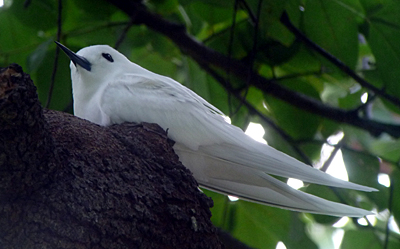 After breakfast, we spent our last hour on Oahu exploring Kapiolani Park. David and Keith had found a nesting Fairy Tern there on the first day and we went to see this beautiful bird perched delicately on a branch of a large tree. Other birds included Rose-ringed Parakeet, Common Waxbill, Spotted and Zebra Doves, Pacific Golden Plover, Red-crested Cardinal, Java Sparrow and a Gray Francolin that was heard calling behind a tennis court.
After breakfast, we spent our last hour on Oahu exploring Kapiolani Park. David and Keith had found a nesting Fairy Tern there on the first day and we went to see this beautiful bird perched delicately on a branch of a large tree. Other birds included Rose-ringed Parakeet, Common Waxbill, Spotted and Zebra Doves, Pacific Golden Plover, Red-crested Cardinal, Java Sparrow and a Gray Francolin that was heard calling behind a tennis court.
Later in the morning we flew to the Big Island of Hawaii enjoying spectacular views of the island’s two volcanoes as the plane descended into Hilo. We checked into our hotel, had lunch and then headed up to Hawaii Volcanoes National Park. On the way to the park, our first Hawaiian Hawk was seen flying above the road. As we reached the visitor center, it was raining lighting but that did not deter us from finding our first Apapanes in the Ohia trees just outside the visitor center Little did we know that we would see many more of this gorgeous, abundant Hawaiian honeycreeper. We ventured over to the historic Volcano House and immediately went to the veranda to enjoy the view of the 2 mile long, 2.5 mile wide Kilauea Caldera. Relative small in comparison to the other two volcanoes, Mauna Kea (13,677 feet) and Mauna Kea (13,796 feet), Kilauea is one of the world’s most active volcanoes with the current eruption having begun in January 1983. Even in the mist, the caldera was impressive and a large steam vent was visible. There were several Ohia bushes just below the overlook with many Apapanes feeding adding to the excitement of the scene. As we worked our way back toward the car park, the first Common/Hawaii Amakihi showed briefly to for Keith, David T., and Steve.
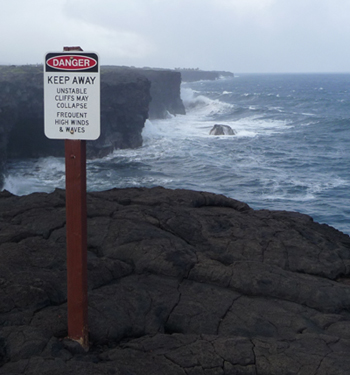 We drove through the park along the Crater Rim Road and turned off on the Chain of Craters Road which led down toward the sea. We crossed an expansive lava flow that was created by Mauna Ulu from 1969 – 1974 and could see sections of the old road that had been covered by the flows. Some areas were bare lava while others had plants colonizing the primordial substrate. It was an unearthly landscape and as we got closer to the sea it was obvious how much new “land” had been created by this flow. We stopped at one point and walked to the edge of the lava where waves were crashing against the low black cliffs. A few Black Noddies were seen flying by and some came into perch on a hollowed out area of lava allowing nice scope views. On the way back up toward the summer, the lava fields were lit up by the sun and the smooth pahoehoe lava looked shiny in the afternoon light. As we ascended, we passed through intermittent showers which produced rainbows. Our last scheduled stop of the day was at the Thurston Lava Tube where we walked a short trail through a fern forest and an elongated lava tube. After exploring this unique area, we left the park and headed back toward Hilo in the rain. David L. spotted a Hawaiian Hawk perched on a palm tree causing us to turned around and go back to get a view of it and we were all pleased with the view considering the wet weather conditions. Back in Hilo, we enjoyed an excellent dinner in a local restaurant before catching up with our checklist for the day.
We drove through the park along the Crater Rim Road and turned off on the Chain of Craters Road which led down toward the sea. We crossed an expansive lava flow that was created by Mauna Ulu from 1969 – 1974 and could see sections of the old road that had been covered by the flows. Some areas were bare lava while others had plants colonizing the primordial substrate. It was an unearthly landscape and as we got closer to the sea it was obvious how much new “land” had been created by this flow. We stopped at one point and walked to the edge of the lava where waves were crashing against the low black cliffs. A few Black Noddies were seen flying by and some came into perch on a hollowed out area of lava allowing nice scope views. On the way back up toward the summer, the lava fields were lit up by the sun and the smooth pahoehoe lava looked shiny in the afternoon light. As we ascended, we passed through intermittent showers which produced rainbows. Our last scheduled stop of the day was at the Thurston Lava Tube where we walked a short trail through a fern forest and an elongated lava tube. After exploring this unique area, we left the park and headed back toward Hilo in the rain. David L. spotted a Hawaiian Hawk perched on a palm tree causing us to turned around and go back to get a view of it and we were all pleased with the view considering the wet weather conditions. Back in Hilo, we enjoyed an excellent dinner in a local restaurant before catching up with our checklist for the day.
Day 4 - Wednesday, April 1, 2009
The Big Island of Hawaii holds the greatest habitat diversity including seacoast, low and high elevation rainforest, high and low dry forest, sub alpine areas, and high elevation desert scrub. This morning we were up early to allow enough time to search some of Big Island’s special endemic and endangered bird species. We set off in our wet weather gear as the rainy weather front was still holding on. Our first destination on Saddle Road was shrouded in thick cloud and heavy rain so we continued on to the leeward side of the island where the weather completely different and welcome - dry and sunny. Along the road, David T. spotted a perched Barn Owl so we all turned around and went back for a view. Further on, we entered the drier forest ecosystem at Pu`u La`au on the slope of Mauna Kea and spotted several of the introduced game species of the area. Groups of California Quail scuttled across the track and several Erckel’s Francolins showed themselves. A Japanese Quail took flight and 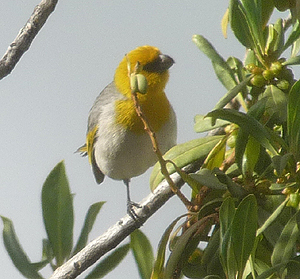 glided down the hillside and House Finch and Eurasian Skylark were common. We parked near a tract that contained the last remaining range of the endangered Palila, a cryptically-colored species of finch-billed Hawaiian honeycreeper. As we were about to set off, a Palila suddenly appeared overhead and landed in the canopy of a large tree. We set up a few scopes, but most of us really didn’t get satisfactory views before it dropped out of the tree and away. From a small lookout we scanned the tree tops and open grassland and found a flock of Wild Turkeys and some Wild Pigs. We then set off on a trail where we soon came across many Hawaii Amakihis, with both males and females showing very well. Further on, David K. heard our main target species, a female Palila, which was seen briefly but disappeared as soon as it was found. It didn’t take long to find another and this time a stunning male with bright yellow head, white under parts and grayish upper parts sat in the open on top of a dead tree allowing us all to get good scope views of it. After a few minutes, it flew off, only to land in a small bush just a few feet from the ground. We approached slowly and got fantastic views as it fed on the berries of a Naio tree. Very happy with our views we slowly made our way back to the parking area seeing many more Hawaii Amakihis along the way.An area near a fence held a pair of the volcano race of Hawaiian Elepaio and they moved out in the open allowing good views.We loaded up the vehicles we drove downhill stopping to try for another look at Japanese Quail. It was a long shot but we needed to try and despite our efforts, we were unable to locate another one. Compensation came in the form of an endemic race of Short-eared Owl that drifted slowly over the hillside.
glided down the hillside and House Finch and Eurasian Skylark were common. We parked near a tract that contained the last remaining range of the endangered Palila, a cryptically-colored species of finch-billed Hawaiian honeycreeper. As we were about to set off, a Palila suddenly appeared overhead and landed in the canopy of a large tree. We set up a few scopes, but most of us really didn’t get satisfactory views before it dropped out of the tree and away. From a small lookout we scanned the tree tops and open grassland and found a flock of Wild Turkeys and some Wild Pigs. We then set off on a trail where we soon came across many Hawaii Amakihis, with both males and females showing very well. Further on, David K. heard our main target species, a female Palila, which was seen briefly but disappeared as soon as it was found. It didn’t take long to find another and this time a stunning male with bright yellow head, white under parts and grayish upper parts sat in the open on top of a dead tree allowing us all to get good scope views of it. After a few minutes, it flew off, only to land in a small bush just a few feet from the ground. We approached slowly and got fantastic views as it fed on the berries of a Naio tree. Very happy with our views we slowly made our way back to the parking area seeing many more Hawaii Amakihis along the way.An area near a fence held a pair of the volcano race of Hawaiian Elepaio and they moved out in the open allowing good views.We loaded up the vehicles we drove downhill stopping to try for another look at Japanese Quail. It was a long shot but we needed to try and despite our efforts, we were unable to locate another one. Compensation came in the form of an endemic race of Short-eared Owl that drifted slowly over the hillside.
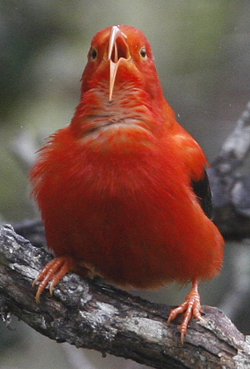 We then continued on and made our way back to our first stop of the morning which had been previously rained out. It was still raining but we had to persist so we wrapped up in our rain gear and took the trail leading into one of the pockets of unique tropical forest that surround the slopes of Mauna Kea (White Mountain). The birds didn’t seem to mind the rain and we soon found our first obliging I’iwi, a stunning bird that fed openly on a flowering Ohia right in front of us. Moving on we entered a patch of forest scattered with large Koa trees, the favored habitat of one of Hawaii’s most difficult and rarest birds, the Akiapola’au a bird recognized for its remarkable bill which has a short lower mandible for chiseling and a long flexible, sharply decurved upper mandible for probing inside cavities. We spent a few cold wet hours searching this woodland, seeing many I’iwis, Apapanes, Hawaiian Elepaio (this time of the Mauna Kea race), and many Hawaiian Amakihis. Some of us were lucky to see a showy Oma’o, an endemic thrush species. Eventually an Akiapola’au was found but the views were not satisfying as it was silhouetted against the pale rainy sky. The bird flew off, and try as we may, we never managed to relocate it. Feeling very soggy and somewhat defeated, we returned to the cars and drove back to our hotel and had time to dry our gear out. Later we met up and drove along the coast to try and view an active lava flow. We reached the parking area and walked a short distance to view a huge steam plume at the edge of the sea. As darkness fell we could also se the glow from the molten lava flowing into the sea, a nice way to end the day.
We then continued on and made our way back to our first stop of the morning which had been previously rained out. It was still raining but we had to persist so we wrapped up in our rain gear and took the trail leading into one of the pockets of unique tropical forest that surround the slopes of Mauna Kea (White Mountain). The birds didn’t seem to mind the rain and we soon found our first obliging I’iwi, a stunning bird that fed openly on a flowering Ohia right in front of us. Moving on we entered a patch of forest scattered with large Koa trees, the favored habitat of one of Hawaii’s most difficult and rarest birds, the Akiapola’au a bird recognized for its remarkable bill which has a short lower mandible for chiseling and a long flexible, sharply decurved upper mandible for probing inside cavities. We spent a few cold wet hours searching this woodland, seeing many I’iwis, Apapanes, Hawaiian Elepaio (this time of the Mauna Kea race), and many Hawaiian Amakihis. Some of us were lucky to see a showy Oma’o, an endemic thrush species. Eventually an Akiapola’au was found but the views were not satisfying as it was silhouetted against the pale rainy sky. The bird flew off, and try as we may, we never managed to relocate it. Feeling very soggy and somewhat defeated, we returned to the cars and drove back to our hotel and had time to dry our gear out. Later we met up and drove along the coast to try and view an active lava flow. We reached the parking area and walked a short distance to view a huge steam plume at the edge of the sea. As darkness fell we could also se the glow from the molten lava flowing into the sea, a nice way to end the day.
Day 5 - Thursday, April 2, 2009
Today we set out early to explore the Hakalau Forest National Wildlife Refuge, a large restricted access area that houses an important tract of Koa-Ohia montane cloud forest on the windward slopes of Mauna Kea volcano. As we drove out Saddle Road it was raining quite hard and we anticipated another very wet day in what we had expected to be sunny Hawaii. We traveled Saddle Road crossing large from old and new flows of pahoehoe and ah-ah lava and then turned off the main road toward the reserve. The landscape was open grassland at first and a flock of Wild Turkeys was seen in the fog. Soon Gorse became prevalent and birds spotted near the road included Erckel’s Francolin, Ring-necked Pheasant, and Eurasian Skylark. We entered through two locked gates and arrived at the reserve. As we approached the grassy parking field a pair of Kalij Pheasants moved off the grass and up the tract behind us.
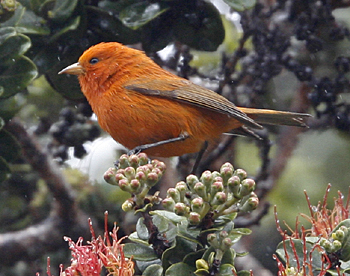 The weather was clear for the moment so we walked an open trail into the reserve of gorgeous Koa and Ohia trees searching for our targets. As we descended a hill, David K. heard the call of an Akepa and we soon spotted a pair of Akepas feeding in an Ohia tree including a beautiful tangerine-orange male. Further on, we all got good views of a Hawaiian Creeper in a tree close to the track and the bird stayed for several minutes while we all watched it foraging on a trunk. On the way back, an Oma’o (Hawaiian Thrush) flew past us and perched atop a tree in the open. Pleased with our finds, we made our way back to a shelter where we ate our picnic lunch. The shelter overlooked an open field and to the right was a large Ohia which had several birds actively feeding on it including I’iwi, Apapane, Japanese White-eye, and Hawaii Amakihi.
The weather was clear for the moment so we walked an open trail into the reserve of gorgeous Koa and Ohia trees searching for our targets. As we descended a hill, David K. heard the call of an Akepa and we soon spotted a pair of Akepas feeding in an Ohia tree including a beautiful tangerine-orange male. Further on, we all got good views of a Hawaiian Creeper in a tree close to the track and the bird stayed for several minutes while we all watched it foraging on a trunk. On the way back, an Oma’o (Hawaiian Thrush) flew past us and perched atop a tree in the open. Pleased with our finds, we made our way back to a shelter where we ate our picnic lunch. The shelter overlooked an open field and to the right was a large Ohia which had several birds actively feeding on it including I’iwi, Apapane, Japanese White-eye, and Hawaii Amakihi.
After lunch, we walked back down the trail surprising a pair of Kalij Pheasants just after we set out. There were numerous Apapanes, I’iwis, and Hawaii Amakihis and another Oma’o. A few of us stayed back at the lunch shelter and witnessed a Barn Owl that flew in over the field and gave a show. We drove back out of the reserve in light rain and had great views of a perched Hawaiian Hawk on the way out.
Day 6 - Friday, April 3, 2009
Today some of us took the opportunity to relax and spend some time exploring Hilo while a few stalwarts went back to get better views of the rare Akiapola’au. Once again, a misty rain was falling as we drove out of Hilo and the rain continued as we arrived at our birding site. We trudged through the ah-ah lava field and then the pahoehoe lava to the kipuka (forest) which we hoped held our quarry. The mist was starting to subside and as we walked through the forest the sun came out for brief moments. We searched for several hours without a glimpse or a call of our target but had great views of many 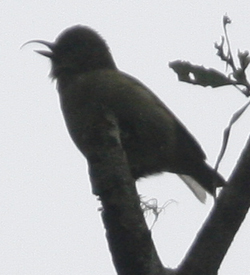 birds including the Hawaii Amakihi, Oma’o, Apapane, and some family groups of Hawaii Elepaio and I’iwi. We birded through lunch and thankfully David K had packed a snack to keep up going. In the afternoon, we spread out to cover more ground visually and David K and Bart checked the adjacent kipuka. The conditions were calm and dry for the moment but our bird was no where to be found. David K walked back to our main search area and in a few minutes summoned us to an area in the forest where he had heard the loud and clear call of an Akiapola’au. It wasn’t long before Steve was on a stunning male Akiapola’au and giving directions but the bird flew off quickly. Foiled again! We spread out again searching the area but the bird was gone. After nearly an hour with no luck, we moved to another area and once again the call was heard. This time, we got on a female Akiapola’au foraging in some moss on a high branch. The bird showed well and when it called we could see the details of its unique bill. We watched this bird for several minutes from different angles and Steve even managed photos albeit record shots. Finally victory! Our patience and perseverance had paid off. After a total of 12+ hours of searching and thanks to David’s persistence and keen ears, we had seen the most difficult Drepanid! We headed back to Hilo on a high and later met the rest of the group for dinner and to share stories of the day.
birds including the Hawaii Amakihi, Oma’o, Apapane, and some family groups of Hawaii Elepaio and I’iwi. We birded through lunch and thankfully David K had packed a snack to keep up going. In the afternoon, we spread out to cover more ground visually and David K and Bart checked the adjacent kipuka. The conditions were calm and dry for the moment but our bird was no where to be found. David K walked back to our main search area and in a few minutes summoned us to an area in the forest where he had heard the loud and clear call of an Akiapola’au. It wasn’t long before Steve was on a stunning male Akiapola’au and giving directions but the bird flew off quickly. Foiled again! We spread out again searching the area but the bird was gone. After nearly an hour with no luck, we moved to another area and once again the call was heard. This time, we got on a female Akiapola’au foraging in some moss on a high branch. The bird showed well and when it called we could see the details of its unique bill. We watched this bird for several minutes from different angles and Steve even managed photos albeit record shots. Finally victory! Our patience and perseverance had paid off. After a total of 12+ hours of searching and thanks to David’s persistence and keen ears, we had seen the most difficult Drepanid! We headed back to Hilo on a high and later met the rest of the group for dinner and to share stories of the day.
Day 7 - Saturday, April 4, 2009
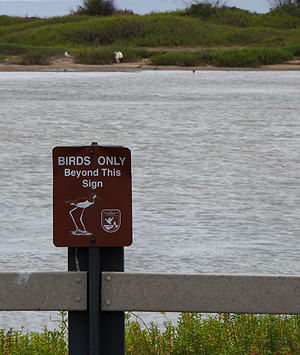 This morning after breakfast we checked the coast near our hotel and found Ruddy Turnstones out on some near shore rocks and a Wandering Tattler. Some ponds near the coast held Cattle Egret, Gadwall, Wandering Tattler, a pair of Mallards, Northern Pintail, Black-crowned Night-Heron, Hawaiian Coot, Yellow-billed Cardinal, Northern Shoveler, and Pacific Golden Plover. As we were getting ready to go back to the vehicles, David L spotted a Lesser Indian Mongoose on the far side of a large pond. From here we went to the airport and flew to Maui, the second largest Hawaiian Island. At Kanaha Pond, not far from the airport, we had great views of Hawaiian Stilt, several Black-crowned Night Herons and a few Hawaiian Coots. We moved on to check Ma'alaea Flats are on the southern end of the central Maui isthmus where there were more Hawaiian Stilts, lots of Black-crowned Night-Herons, Pacific Golden Plover, a small flock of Sanderlings, and a lone Dunlin.
This morning after breakfast we checked the coast near our hotel and found Ruddy Turnstones out on some near shore rocks and a Wandering Tattler. Some ponds near the coast held Cattle Egret, Gadwall, Wandering Tattler, a pair of Mallards, Northern Pintail, Black-crowned Night-Heron, Hawaiian Coot, Yellow-billed Cardinal, Northern Shoveler, and Pacific Golden Plover. As we were getting ready to go back to the vehicles, David L spotted a Lesser Indian Mongoose on the far side of a large pond. From here we went to the airport and flew to Maui, the second largest Hawaiian Island. At Kanaha Pond, not far from the airport, we had great views of Hawaiian Stilt, several Black-crowned Night Herons and a few Hawaiian Coots. We moved on to check Ma'alaea Flats are on the southern end of the central Maui isthmus where there were more Hawaiian Stilts, lots of Black-crowned Night-Herons, Pacific Golden Plover, a small flock of Sanderlings, and a lone Dunlin.
Later in the afternoon we drove up the scenic road into Haleakala National Park, one of the oldest National Parks in America established in 1916. We ascended the road to the summit, touted as the steepest paved road on the planet. Combine that with numerous hairpin turns and incredible panoramic vistas and it was an exhilarating journey. At the top at 10,000 feet, we had misty views of Haleakala Crater, the largest dormant volcano in the world at 7.5 miles long and 2.5 miles wide. From the top, we could see the floor of the Crater and its numerous cinder cones. The landscape was unearthly and dotted with a few native Silversword plants of the Haleakala subspecies which grows in a low rosette for years before sending up a tall spike of composite flowers. While enjoying the view, Steve spotted a Petrel flying over a distant hill near the Visitor Center below. We quickly moved down to the Center and walked out to the edge of the path. In a few minutes, we spotted the rare and endangered Hawaiian Petrel, flying over the lava hills. This was the first time David K had seen this pelagic bird in daylight as normally they stay out at sea except when they come to nest in burrows along the Haleakala Crater. Some of the birds started coming close to us and a few flew right over our heads eliciting gasps of delight from the crowd. Amazing! We witnessed courtship flights and could hear the birds calling and enjoyed this incredible experience as the sun set in the distance. In all, we saw at least twelve of these remarkable birds and it was a highlight of the trip! As darkness fell, we made our way back to the vehicles and enjoyed our picnic dinner while recounting this fabulous experience. The ride down the road was exhilarating to say the least and we returned to the hotel and retired for the evening.
Day 8 - Sunday, April 5, 2009
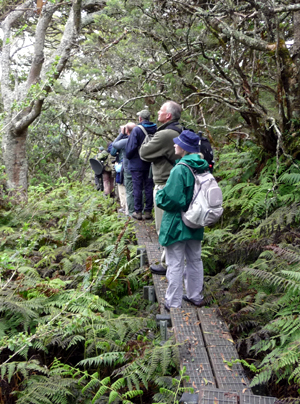 This morning we were out early heading toward Haleakala National Park. After breakfast at David’s favorite place, we headed up the long winding road to the entrance gate where two Nenes were showing well next to the road. The birds were banded but are considered wild so we finally had this important endemic under our belt. We continued on to Waikamoi Preserve operated by the Nature Conservancy. With special permission, we were one of the first groups to be allowed access to this important reserve under the guidance of Chuck Probst and Mike Ord of the American Birding Association. While Chuck oriented us to the reserve we saw our first of many endemic Alauahio (Maui Creeper).
This morning we were out early heading toward Haleakala National Park. After breakfast at David’s favorite place, we headed up the long winding road to the entrance gate where two Nenes were showing well next to the road. The birds were banded but are considered wild so we finally had this important endemic under our belt. We continued on to Waikamoi Preserve operated by the Nature Conservancy. With special permission, we were one of the first groups to be allowed access to this important reserve under the guidance of Chuck Probst and Mike Ord of the American Birding Association. While Chuck oriented us to the reserve we saw our first of many endemic Alauahio (Maui Creeper).
We walked through an exotic forest into another area with native trees and spent a long time looking for the targets here. There were plenty of I’iwi, Apapane and Alauahio and we heard a few Japanese Bush Warblers but focused our efforts on the difficult Akohekohe (Crested Honeycreeper), the exceptionally rare Maui Parrotbill. Chuck shared his knowledge of the area with us as we made our way to an area that had been used as a helicopter pad to bring in supplies to build a boardwalk on the hillside. We walked down the boardwalk through the forest to an observation platform where we were to stake out our target birds. Late in the morning, some of us walked up the boardwalk to stretch our legs. After awhile, David L. spotted the first Maui Parrotbill just a few yards up from the observation platform. We all rushed up as quickly as we could but the bird had disappeared. An hour later the bird showed again, this time it sat and preened for long enough for more of us to get views including Mike who had been searching for this bird for 45 years! Finally, he had his reward with a good view of it! In a few minutes the bird showed again for the last time allowing a few more people to catch up with it. There were still a few who had not seen the bird so we watched the area intently for several minutes but it did not show again. Instead, an Akohekohe flew in and perched briefly to the delight of those in the right spot. With another victory under our belts we made our way back up to the vehicles and celebrated with some beers that Chuck had brought in anticipation of our success. We drove back down the mountain to our hotel and enjoyed another lovely meal David’s favorite restaurant in town.
Day 9 - Monday, April 6, 2009
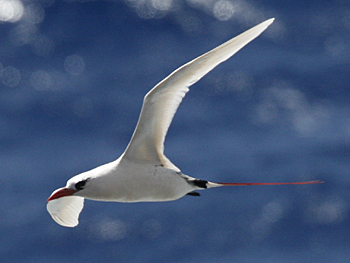 This morning after breakfast we headed to the airport making a quick stop at the Kanaha Ponds yielded Hawaiian Stilts, a Black-crowned Night Heron and a pair of Gray Francolins near a fence at the side of the road. We took a flight to Kauai, the “ Garden Island”, and the oldest of the main islands. On arrival we went directly to our hotel across from the beach and settled into our rooms. The palm trees blowing in the gentle breeze, warm temperature, and lack of fast food and chain stores made this feel like the Hawaii we had imagined before the trip. After lunch, we drove up to the north coast of the island to visit Kilauea Point National Wildlife Refuge. The number of Hawaiian Chickens passed 100 just along the road as we drove. Nenes greeted us at the entrance gate and as we walked up to the lighthouse we noted the hillside full of Red-footed Boobies on nests overlooking the sea. Further on, we spotted several Laysan Albatrosses displaying on a hill on the other side and a large fluffy chick near a fence in the background. The albatrosses flew toward the point catching the wind just in front of us making for excellent views. Several Red-tailed Tropicbirds were also flying near the cliff top and to our surprise a Wedge-tailed Shearwater was sitting at the opening of a burrow just inches from where we were standing.
This morning after breakfast we headed to the airport making a quick stop at the Kanaha Ponds yielded Hawaiian Stilts, a Black-crowned Night Heron and a pair of Gray Francolins near a fence at the side of the road. We took a flight to Kauai, the “ Garden Island”, and the oldest of the main islands. On arrival we went directly to our hotel across from the beach and settled into our rooms. The palm trees blowing in the gentle breeze, warm temperature, and lack of fast food and chain stores made this feel like the Hawaii we had imagined before the trip. After lunch, we drove up to the north coast of the island to visit Kilauea Point National Wildlife Refuge. The number of Hawaiian Chickens passed 100 just along the road as we drove. Nenes greeted us at the entrance gate and as we walked up to the lighthouse we noted the hillside full of Red-footed Boobies on nests overlooking the sea. Further on, we spotted several Laysan Albatrosses displaying on a hill on the other side and a large fluffy chick near a fence in the background. The albatrosses flew toward the point catching the wind just in front of us making for excellent views. Several Red-tailed Tropicbirds were also flying near the cliff top and to our surprise a Wedge-tailed Shearwater was sitting at the opening of a burrow just inches from where we were standing.
In the bay on the quieter side of the point, there were several Spinner Dolphins in the water some of them spinning as they jumped out of the water. There were several Humpback Whales in the near shore waters and a couple of Pacific Green Sea Turtles were floating near the surface of the water. Brown Boobies and Great Frigatebirds were about and the whole scene was magical.
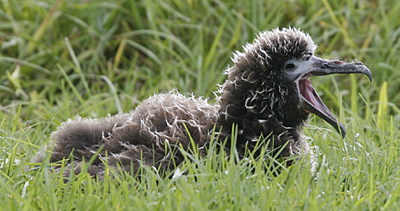 It was getting late in the afternoon and we had a few more stops to make so we continued further north into a posh housing development where we found a Laysan Albatross chick on the ground in a lot between two of the houses. Though it looked vulnerable, there were signs posted informing people that the chick was being tended to by its parents and to leave it alone and keep domestic animals under control. It was a sight unlikely probably anywhere else – a baby albatross in a housing development. We moved to another area where a pair of adult Laysan Albatross was displaying behind a house – an interesting yard bird. As we positioned ourselves to get better views, we saw another chick, this time sat in a garden bed near a pink flowering bush. Incredible!
It was getting late in the afternoon and we had a few more stops to make so we continued further north into a posh housing development where we found a Laysan Albatross chick on the ground in a lot between two of the houses. Though it looked vulnerable, there were signs posted informing people that the chick was being tended to by its parents and to leave it alone and keep domestic animals under control. It was a sight unlikely probably anywhere else – a baby albatross in a housing development. We moved to another area where a pair of adult Laysan Albatross was displaying behind a house – an interesting yard bird. As we positioned ourselves to get better views, we saw another chick, this time sat in a garden bed near a pink flowering bush. Incredible!
As the sun was setting we made our way back to Lihue and went to dinner overlooking the beach and bay across from our hotel.
Day 10 - Tuesday, April 7, 2009
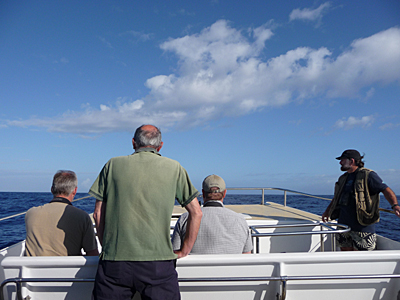 Today we embarked on a pelagic trip in the offshore waters of Kauai. We made our way down to the docks where there were several Globe Skimmer dragonflies flying by presumably in migration. It was a lovely sunny day with fair weather clouds and our Captains Rob and Chad greeted us and welcomed us aboard a 49-foot custom power catamaran which they called “the Cadillac of the fleet”. It was certainly very roomy and comfortable and we set out to cruise the west side of the island in the channel between Kauai and Nihau. Wedge-tailed Shearwaters were the first and most common birds seen. The sea conditions were fairly calm with a little chop to start and Captain Rob kept us informed as we encountered swells from all different directions. We had great views of Great Frigatebirds, Red-footed Booby, Brown Booby, White-tailed Tropicbird, and Laysan Albatross and added Sooty Shearwater to our trip list. A couple of Rough-toothed Dolphins showed briefly just before we encountered a “bird pile” which included Brown Noddies and a Black Noddy. Excitement ensued when a Humpback Whale surfaced not far off and as we were watching it a Black-footed Albatross appeared in the air above it. Already looking in the right direction we got great views of the bird. Suddenly we heard the buzz of a fishing pole and soon Diane was pulling in a Skipjack Tuna. Another hit and Steve grabbed a pole but his massive fish was stolen by a shark before he could reel it in.
Today we embarked on a pelagic trip in the offshore waters of Kauai. We made our way down to the docks where there were several Globe Skimmer dragonflies flying by presumably in migration. It was a lovely sunny day with fair weather clouds and our Captains Rob and Chad greeted us and welcomed us aboard a 49-foot custom power catamaran which they called “the Cadillac of the fleet”. It was certainly very roomy and comfortable and we set out to cruise the west side of the island in the channel between Kauai and Nihau. Wedge-tailed Shearwaters were the first and most common birds seen. The sea conditions were fairly calm with a little chop to start and Captain Rob kept us informed as we encountered swells from all different directions. We had great views of Great Frigatebirds, Red-footed Booby, Brown Booby, White-tailed Tropicbird, and Laysan Albatross and added Sooty Shearwater to our trip list. A couple of Rough-toothed Dolphins showed briefly just before we encountered a “bird pile” which included Brown Noddies and a Black Noddy. Excitement ensued when a Humpback Whale surfaced not far off and as we were watching it a Black-footed Albatross appeared in the air above it. Already looking in the right direction we got great views of the bird. Suddenly we heard the buzz of a fishing pole and soon Diane was pulling in a Skipjack Tuna. Another hit and Steve grabbed a pole but his massive fish was stolen by a shark before he could reel it in.
There were a few Sooty Terns around and a Gray-backed Tern made a quick appearance as did a small flock of Gray Phalaropes. The return trip was much choppier making it difficult to discern birds but several Flying Fish were easy to see as they took flight from right next to the boat. Some smaller, dark shearwaters were identified as Christmas Shearwaters and we had a very close encounter with a Hammerhead Shark. In all, we had a successful trip with a dozen species and some new ones for our list.
After lunch and a short break we went out to the lighthouse to sea watch. There were lots of Boobies, Wedgies, and Humpback blows but most were too distant for good views. On the way back to the hotel, we stopped for some good looks at Koloa (Hawaiian Ducks) in a pond next to a golf course. We returned to the hotel and met up with Judith and Diane who had spent the day exploring the island and making friends with the locals. We went back to the waterfront for dinner, this time in an excellent Italian restaurant.
Day 11 - Wednesday, April 8, 2009
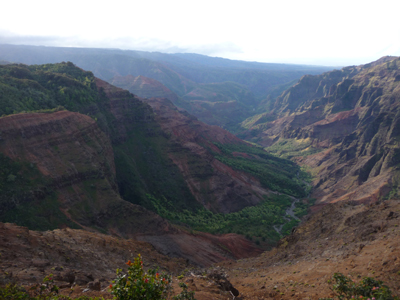 This morning we were out early heading for the lush forests on the mountains of west central side Kauai, home to some of Kauai’s endemic forest birds. As we ascended the Canyon Road up toward Kokee State Park, we had sunlit views of Waimea Canyon, described by Mark Twain as the Grand Canyon of the Pacific. At one of the overlooks, we took in the view again as resident White-tailed Tropicbirds cruised over the canyon below us and a group of Mouflon Sheep walked along a steep hillside. David T and Keith were in hot pursuit of a Kauai Elepaio and the ever present Hawaiian Chickens roamed the car park.
This morning we were out early heading for the lush forests on the mountains of west central side Kauai, home to some of Kauai’s endemic forest birds. As we ascended the Canyon Road up toward Kokee State Park, we had sunlit views of Waimea Canyon, described by Mark Twain as the Grand Canyon of the Pacific. At one of the overlooks, we took in the view again as resident White-tailed Tropicbirds cruised over the canyon below us and a group of Mouflon Sheep walked along a steep hillside. David T and Keith were in hot pursuit of a Kauai Elepaio and the ever present Hawaiian Chickens roamed the car park.
We continued up turning off onto a bumpy road which led to a trail head into the Alakai Wilderness. A trail stretched along a ridge through the wet mountain forest and then a high elevation bog, and as we walked, David pointed out some of the endemic and introduced plants in the area. There were many Japanese White-eyes around, as well as Apapane, I’iwi and an Anianiau was heard though David was concerned at the lack of activity in the forest. White-rumped Shama was also seen and Diane D found a Metallic Skink on the trail. A few hearty souls hiked up a stream where David K had seen some of the rarer forest birds but all that was about was a Puaiohi (Small Hawaiian Thrush) that flew over too quickly to see. Those of us that chose not to forge the stream enjoyed slow, quiet walks back to the car park and good views of the more common birds.
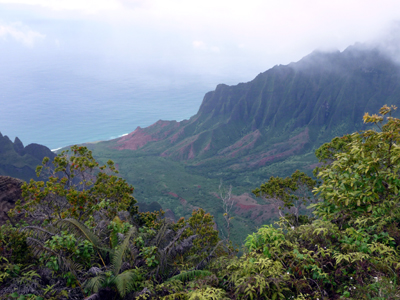 After lunch at a local lodge, we checked some viewpoints overlooking the rugged Na Pali coast. Birds included Japanese White-eyes, I’iwis, Apapanes, and a female Anianiau which we all finally got good views of (again with patience!). On the way down we took in more views of Waimea Canyon and some of us got another look at Pueo, an endemic subspecies of Short-eared Owl. Back in town we all met for dinner at a Mexican restaurant where Bart used his Dutch charm to somehow convince our server to spoon feed him a desert!
After lunch at a local lodge, we checked some viewpoints overlooking the rugged Na Pali coast. Birds included Japanese White-eyes, I’iwis, Apapanes, and a female Anianiau which we all finally got good views of (again with patience!). On the way down we took in more views of Waimea Canyon and some of us got another look at Pueo, an endemic subspecies of Short-eared Owl. Back in town we all met for dinner at a Mexican restaurant where Bart used his Dutch charm to somehow convince our server to spoon feed him a desert!
Day 12 - Thursday, April 9, 2009
This morning, half the group were up very early to set off into the mountains where they were to undertake a long, difficult hike in search of several very rare and endangered species. The other half of our group remained behind before venturing off to explore the northern side of the island. Those of us on the hike drove up into the mountains following narrow muddy tracks until we reached our start point. From here we carried our lunches and water and with the aid of walking sticks we set off on the nine mile round trip hike into pristine forest. Our first challenge was to negotiate a stream and then we slowly made our way higher and higher through the forest, passing spectacular waterfalls, and Hawaii’s equivalent of the Grand Canyon. A few Apapanes were noted and Kauai Elepaios were not only plentiful but very inquisitive, coming in very close to have a look at us. We then spotted an Akekee which didn’t stay long enough for everyone to get on before flying off. Moving on, we trudged through wet bogs, past moss laden trees, through thick bracken, and across the forested ridge of a mountain until we finally arrived at a plateau and the area we were to search for our special targets. As we worked our way in, around and over wet, mossy lichen covered trees David K heard the distinctive call of an Akikiki (Kauai Creeper), a critically endangered Kauai endemic. We soon found not one but a family of two adults and a juvenile working the trees just in front of us and enjoyed excellent views. This particular species is in serious decline and getting harder to find each year so we felt privileged to get such views. Nearby a male Anianiau called and we soon got superb looks at this little gem as it moved through the tree tops above us. This species, again confined to Kauai, is a little more plentiful but still considered vulnerable. One of the hardest birds to find then called and we were on the hunt for the Puaiohi (Small Kauai Thrush) an inhabitant of the most remote rocky plateaus and once again one of Kauai’s most critically endangered species. The bird never called again and could not be found, but we were in prime habitat so we staked out an area in which we could view several directions and sat and waited. David made a few squeaking noises and soon we were joined by Kauai Elepaio, a male Anianiau, Apapane, and 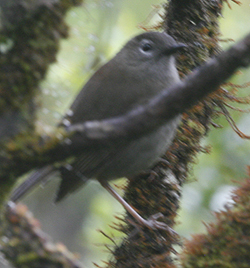 right in front of some of us was a stunning male Akekee. From where I stood, a sudden movement drew my attention to a small Gray thrush perched on a mossy branch in full view. There it was the rarely seen Puaiohi, and within a few seconds all of us were watching this fantastic bird. It is at times like this that you wish you had checked the settings on your camera, and after taking a couple of shots of this bird which was posing beautifully it became obvious my shutter speed was too low and hence I only got blurry photos! Anyway, we had all seen our last Hawaiian endemic of the trip, and our long hike had been very worthwhile. It was now time to eat our snack lunch and set off back towards our vehicle. A good look at a Kauai Amakihi sent us on our way, and several hours of walking eventually saw our return. Leaving the mountains we made our way to the coast and drove to an area of pools and ponds. A look around here found us several Hawaiian Stilts, Turnstones, Wandering Tattler, Common Moorhens and the endemic Hawaiian Coot. In the scrub and bushes there was Japanese White-eyes, Northern Mockingbird, Red-crested Cardinal, House Finch, Scaly-breasted Munias and a calling Black Francolin. A few of us check the ponds for Dragonflies and found Green Darner and Globe Skimmer.
right in front of some of us was a stunning male Akekee. From where I stood, a sudden movement drew my attention to a small Gray thrush perched on a mossy branch in full view. There it was the rarely seen Puaiohi, and within a few seconds all of us were watching this fantastic bird. It is at times like this that you wish you had checked the settings on your camera, and after taking a couple of shots of this bird which was posing beautifully it became obvious my shutter speed was too low and hence I only got blurry photos! Anyway, we had all seen our last Hawaiian endemic of the trip, and our long hike had been very worthwhile. It was now time to eat our snack lunch and set off back towards our vehicle. A good look at a Kauai Amakihi sent us on our way, and several hours of walking eventually saw our return. Leaving the mountains we made our way to the coast and drove to an area of pools and ponds. A look around here found us several Hawaiian Stilts, Turnstones, Wandering Tattler, Common Moorhens and the endemic Hawaiian Coot. In the scrub and bushes there was Japanese White-eyes, Northern Mockingbird, Red-crested Cardinal, House Finch, Scaly-breasted Munias and a calling Black Francolin. A few of us check the ponds for Dragonflies and found Green Darner and Globe Skimmer.
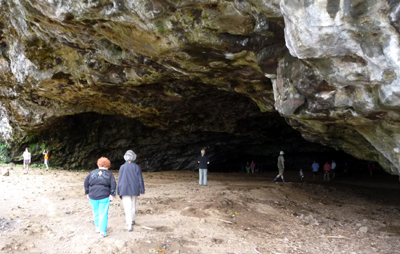 The other group had a more relaxing day on the north coast first visiting Limahuli Botanical Garden and then checking some beaches for seabirds. On the drive up there were plenty of Hawaiian Chickens and a White-rumped Shama was particularly showy perched on a wire. Except for a group of Black Noddies at Ke’e Beach, the sea was devoid of birds. After exploring a large lava tube, we returned to Kilauea Point National Wildlife Refuge to sea watch at the lighthouse. Nenes greeted us in the car park and Red-footed Boobies dotted the adjacent hillside and struggled to fly against the strong wind. There were several Laysan Albatross around and the chick we had seen a few days ago was sitting up an in better view than before. The Red-billed Tropicbirds were doing their courtship flights and a few Great Frigatebirds were patrolling along the cliffs. The Wedge-tailed Shearwater burrows were obviously active but only one bird was seen over the water. Diane was enjoying some views of Spinner Dolphins when Gina called her over to see some close Humpback Whales that were pec slapping and fluking. Two adults and a young whale were moving together slowly past the point and we got the best views of the trip of these leviathans! On the way back toward Lihue, we had a Western Meadowlark fly across the road. Further on, we stopped at a picturesque overlook with a waterfall on one side and a winding river on the other. Our last stop was at an arboretum where we could hear a Greater Necklaced Laughingthrush in the forest. The skies opened up and we thought it best to drive back across a stream we had crossed before the water level got too high. The antics of some young men and their four-wheel drive trucks kept us entertained briefly and then we moved on to one last stop at a reservoir which held Hawaiian Coot and several Japanese White-eyes in the trees at the water’s edge. We returned to Lihue and our last evening was spent at our favorite Italian restaurant, a very nice way to end our Hawaiian adventure.
The other group had a more relaxing day on the north coast first visiting Limahuli Botanical Garden and then checking some beaches for seabirds. On the drive up there were plenty of Hawaiian Chickens and a White-rumped Shama was particularly showy perched on a wire. Except for a group of Black Noddies at Ke’e Beach, the sea was devoid of birds. After exploring a large lava tube, we returned to Kilauea Point National Wildlife Refuge to sea watch at the lighthouse. Nenes greeted us in the car park and Red-footed Boobies dotted the adjacent hillside and struggled to fly against the strong wind. There were several Laysan Albatross around and the chick we had seen a few days ago was sitting up an in better view than before. The Red-billed Tropicbirds were doing their courtship flights and a few Great Frigatebirds were patrolling along the cliffs. The Wedge-tailed Shearwater burrows were obviously active but only one bird was seen over the water. Diane was enjoying some views of Spinner Dolphins when Gina called her over to see some close Humpback Whales that were pec slapping and fluking. Two adults and a young whale were moving together slowly past the point and we got the best views of the trip of these leviathans! On the way back toward Lihue, we had a Western Meadowlark fly across the road. Further on, we stopped at a picturesque overlook with a waterfall on one side and a winding river on the other. Our last stop was at an arboretum where we could hear a Greater Necklaced Laughingthrush in the forest. The skies opened up and we thought it best to drive back across a stream we had crossed before the water level got too high. The antics of some young men and their four-wheel drive trucks kept us entertained briefly and then we moved on to one last stop at a reservoir which held Hawaiian Coot and several Japanese White-eyes in the trees at the water’s edge. We returned to Lihue and our last evening was spent at our favorite Italian restaurant, a very nice way to end our Hawaiian adventure.
Day 13 - Friday, April 10, 2009
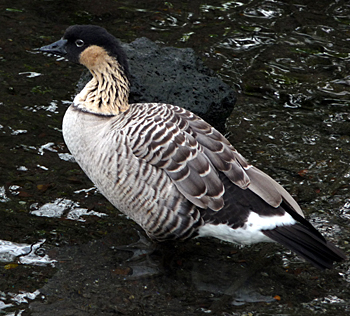 This morning we set off early to the airport where we said our goodbyes to David Kuhn, our expert local guide who knows the islands’ birds probably better than anyone else. Our group had managed to see every available endemic bird species, albeit not everyone saw everything. A lot of the endemics required either patience, hard work or both, and with David’s determination and perseverance, the tour was 100% successful, a great achievement for our first tour to Hawaii.
This morning we set off early to the airport where we said our goodbyes to David Kuhn, our expert local guide who knows the islands’ birds probably better than anyone else. Our group had managed to see every available endemic bird species, albeit not everyone saw everything. A lot of the endemics required either patience, hard work or both, and with David’s determination and perseverance, the tour was 100% successful, a great achievement for our first tour to Hawaii.
We then caught our flight back to Oahu where we had an all day wait for our respective international flights. The tour was officially over so everyone spent the day doing their own thing, while for once in our lives both me and Gina had time to try and complete the write up of this report.
Apart from the unseasonal weather, it had been a great trip with a fun group of people who all got on together wonderfully. We would like to thank everyone for the laughs and making this an enjoyable tour. Aloha!
Steve and Gina
